Your HR recruitment software can play a pivotal role in your organisation’s success. Sourcing, screening and acquisition aside, your hiring systems make those all-important first impressions, and can drastically reduce the administrative burden on your hiring team. Are you making the most of your technology? Discover the ways an automated hiring system can transform your recruitment strategy
‘Digital maturity’ —defined by BCG as ‘a measure of an organization’s [sic] ability to create value through digital’ — is a reliable predictor of success for organisations across various areas. People, processes and profit are closely linked to digital maturity, and in a world of remote and hybrid working, it’s perhaps never been a higher priority.
HR teams are uniquely placed to lead the charge in digital maturity, and automation can help to achieve it more effectively. From basic process automation to intelligent automation and machine learning, replacing manual processes can have a meaningful and far-reaching impact on the way you attract, engage, hire and retain talent. And at a time when skills shortages are rife — with as many as seven million workers anticipated to be under-skilled for their job requirements in the next decade — any measure that can help bridge that gap is worth considering.
We’ve sourced some real-world statistics about the biggest challenges facing hiring teams, and will share some insights into how this new wave of technology can help you overcome them.
The link between technology and top talent
Are you one of the many organisations looking to attract and retain top talent? If so, you’ll understand the importance of the employee experience. It starts from the moment a candidate clicks on your job listing, and continues throughout every stage of the employee lifecycle. That’s why it’s so important to establish — and maintain — a positive experience from the outset.
It’s also important to remember that a positive experience may look different for each candidate and employee. The workforce is changing rapidly, and virtual recruitment can be challenging. A volatile recruitment landscape, high attrition rates, and day-to-day challenges facing most growing organisations add to the complexity of this task.
However, modern problems require modern solutions. Technology, especially with the current advancements in automation and AI, can help HR teams take back valuable time, improve their hiring strategies, and more efficiently manage recruitment processes and practices.
Does technology have the potential to lead the charge in ‘the future of recruitment’? Lucy O’Callaghan, head of talent at Ciphr, says: “Automation allows your recruitment team to work in the most effective and efficient way possible. Using automation functionality early on in the employee lifecycle allows us to not only find the right [candidate] fit for the role, but also gives our applicants the best experience. It gives them a taste of what working at Ciphr is like.
“Recruitment teams are busier than ever,” she adds. “Having this ‘one-stop shop’ for attracting, sourcing, evaluating and hiring candidates saves hours, and gives the team autonomy to manage the entire process without inter-dependency. An intuitive automated recruitment system is (almost) as good as having an extra team member.
“Lastly, as we — and many other organisations — move into a digital-first age, we need to embrace changing technology and make the best use of it where it already exists. A cloud-based hiring system gives recruitment teams on-demand access, which is mission-critical when trying to fill a role urgently: no need to be in a certain place means we can respond rapidly and engage top candidates in record time. All of that without compromising personal data. It can make or break a recruitment strategy.”
Broadly speaking, technology underpins many successful recruitment and HR-related processes. But what are the biggest challenges HR teams are facing, and how can you leverage the functionality of your hiring software to overcome them?
Five real challenges automated hiring systems can help you overcome
- Keeping pace with changing technology
- The (changing) workforce is demanding more
- Skills shortages and extended recruitment cycles exacerbate hiring challenges
- Time-consuming processes for ordinary vacancies add to high workloads
- Managing employer brand has never been more important
Problem 1: keeping pace with changing technology
You’re not imagining it: smart tech is becoming outdated faster each year (in fact, this phenomena has a name: the ‘velocity of obsolescence’). The more advanced technology becomes, the quicker it needs replacing – and recruitment screening software is no exception.
How can organisations keep pace? It’s not nearly as straightforward to replace multiple systems as it is to update your phone to the latest operating system. The trick is to keep an eye on the trends gaining traction: what are your competitors doing differently? What technology are other industry leaders adopting? What are the biggest names in tech regularly speaking about? Forbes succinctly shines a spotlight on the prevalence of AI — of which automation is a large component — as a trend to “be ready for.” Is this an opportune time to be an early adopter?
The solution: look to leaders; anticipate and embrace the change
How are industry leaders capitalising on recruitment automation right now, and how can you replicate that in your organisation?
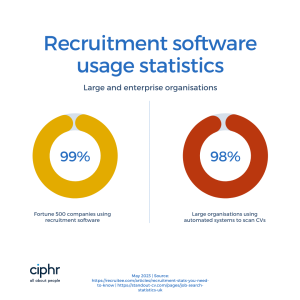
For medium and large organisations conducting recruitment in-house, automation is key to ensuring hiring teams are as efficient as possible. The simplest solution is to embrace the change on an appropriate scale for your organisation: take the next step with your technology either by making better use of what you already have, or upgrading to something more closely aligned with your objectives.
Automated hiring systems can help you bridge the gap between changing tech and changing demands. Modern recruitment technology allows you to screen, pre-qualify, shortlist, engage with, and progress successful candidates while maintaining high-value interactions at critical points throughout the process. Not only will this speed up a typically lengthy hiring process, but if your recruitment software integrates with other HR systems — such as onboarding software, and ID and background checking systems — you can solidify the candidate experience from the first interaction through to their first day. Embracing technological change allows your organisation to demonstrate to potential applicants that your organisation is the right option for them, and allows each human interaction to be more meaningful.
Problem 2: the (changing) workforce is demanding more
As if it weren’t enough to keep pace with changing technology, the changing workforce comes with its own set of challenges and demands. More candidates are looking to their prospective employer to offer more than the norm; the so-called ‘great resignation’ triggered a ripple effect on the labour market, which is still skewed in the candidates’ favour despite economic uncertainty.
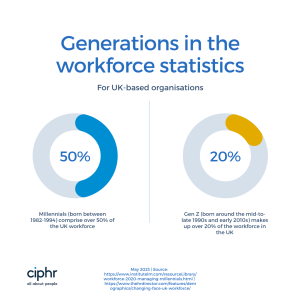
Combined, younger generations now make up the majority of the workforce. This means there’s a need for organisations to shift the way they attract and retain talent to cater for the cultural, societal and economic nuances of millennial and gen Z workers, while not alienating other generations. The labour market is still facing challenges with hard-to-fill vacancies, and few organisations can afford to have prime candidates slip through the cracks.
Gen Z — the first digital natives, born around the mid-to-late 1990s and early 2010s — ranks their relationship with their work team as one of their top concerns, and the majority (68%) of this generation welcome AI and other technology at work.
Millennials — born between 1982 and 1994 — are the largest component of today’s workforce and will spend four years applying for jobs throughout their lives. They’re well-versed in what makes for a good employee experience – and if yours falls short at the recruitment phase, you may be missing out on exceptional talent.
The solution: create a positive employee experience and leverage technology to deliver more opportunities
Using automation technology to shorten, simplify, and streamline this process will leave a great impression on your applicants — and can help your HR team to identify the ideal time to reach out in-person. Offering a human connection at the right time can elevate the experience and open the door to more meaningful conversations.
In the Telegraph’s Future Workforce Report, Chris Gray, brand leader at Manpower UK, said: “The best approach for HR is to blend high-tech with a high-touch approach. HR leaders can use automation and artificial intelligence (AI) to reduce the administrative burden and streamline hiring processes, without losing the personal interaction that candidates have come to value in recent years. In fact, with so much of the initial contact between candidates and employers becoming automated, the need for in-person interaction is only set to further increase in importance.”
Digital natives and early adopters are not only familiar with advancing technology, but they have also come to expect it as standard. Elements like personalisation, rapid feedback, and engagement should be business-as-usual, and automated ATS recruitment software can help you set and manage these expectations almost effortlessly. Differences aside, all generations of workers can agree that the employee experience is important, and a well-structured recruitment process can enhance this.
Having control over automated engagements allows organisations to provide all the information candidates want, whether that’s about company culture, pay and role transparency, and diversity, equality and inclusion (DE&I) practices, for example. By providing this information upfront, more candidates are inclined to continue their applications, while HR teams have more opportunities to engage in meaningful conversations with candidates.
This also builds trust, supports you in creating a reputable employer brand, and will all add up to greater talent attraction and retention in the long run.
Problem 3: skills shortages and extended recruitment cycles exacerbate hiring challenges
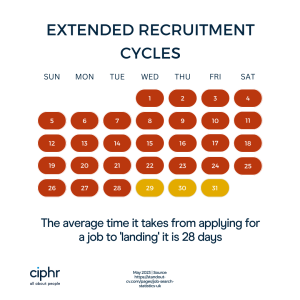
Not only is it difficult to find talent, but it takes, on average, a month to fill a vacancy. Any organisation grappling with unfilled vacancies will want its HR team to place a candidate as soon as possible. Using technology to attract more talent, and engage them more effectively, will only support the initial phase of the hiring process. There are a to placing the wrong candidate, including low productivity, decreased morale, and reputational damage, to name but a few. So how can HR teams reduce time to hire without compromising the quality of hire?
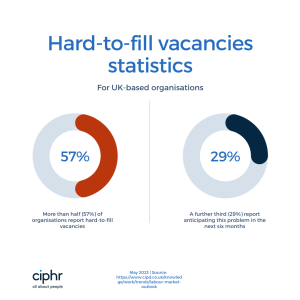
The solution: reach highly skilled candidates and hire them more effectively
Ciphr’s talent team has taken steps to achieve shorter recruitment cycles by leveraging recruitment technology. “The key to reducing your time to hire starts and ends with having effective processes in place, and this is underpinned by an applicant tracking system (ATS),” says O’Callaghan. “Everything is in one place, which helps keeps the candidates engaged as it makes the process easier for the recruitment team to manage.”
To help you achieve the same results, here are Ciphr’s talent team top recommendations and insights:
- Automated bulk communication speeds up the typically long process of screening candidates. An ATS isn’t bound by office hours, so you’re can use automated responses to engage appropriate candidates after hours, reducing your time spent on manual communication
- Posting job adverts to multiple job boards helps to attract and reach different candidates. It helps to have a central database (ie your ATS) to manage multiple postings and applications
- Filtering and scanning CVs in line with role requirements will help to eliminate inappropriate candidates. You should be sure to include a range of keywords within your filters, as candidates from other countries may use different terminology. To avoid incorrectly disqualifying them, your filters must include a matrix of semantic keywords
- Ask ‘killer questions’ to rule out candidates that won’t fit the role. If you have a non-negotiable requirement, posing a yes/no question to ensure applicants meet that minimum threshold is a great way of sorting through high volumes of CVs that simply don’t meet the needs of the role
- Grow your talent pool by compliantly retaining CVs of applicants who may be a good fit for future roles. Your ATS can manage GDPR permissions and securely store CVs for you to consider as new vacancies arise
Problem 4: tedious, time-consuming processes for entry-level vacancies add to high workloads
While high-skilled vacancies are problematic and hard-to-fill, entry-level vacancies are proving equally difficult. Without automated intervention, you risk passing up some of the best candidates and the opportunity to recruit faster.
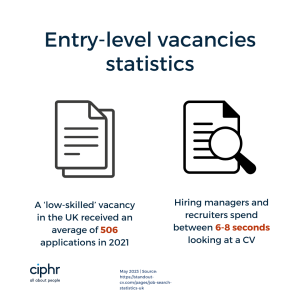
To view 506 applications for each ordinary vacancy equals an average of 50-68 uninterrupted minutes of screening CVs per role – not including room for error.
Recruitment is only a portion of the day-to-day activities of a hiring manager, and to spend over an hour screening CVs for one role quickly becomes unsustainable. There’s also the risk of unconscious bias which can severely hamper both organisational and role-specific objectives.
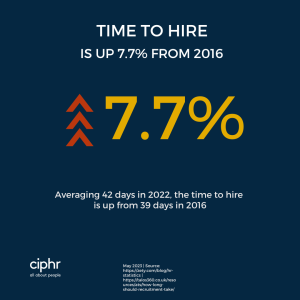
Whether you’re screening for high-skilled or ordinary vacancies, relying on manual processes for any volume of applications carries unnecessary risk and places an unfair burden on the hiring manager. Simply setting up your ATS to automate this process will eliminate human error and buy back hours of valuable time, while highlighting the most appropriate candidates. Plus, there are even AI tools on the market that can help speed up (and improve) your candidate matching processes.
The solution: automate repetitive tasks, save valuable time, remove room for human error
Say goodbye to manual screening: automate the process of pre-screening, shortlisting, interview scheduling and more by setting filters in your recruitment screening software.
You can further set up your screening criteria to shortlist candidates with the best skills, experience, and qualifications for the role, while reserving applications from candidates with a close (but not quite ‘exact’) match for the role so you can manually review them and make a data-based decision on whether to progress their application or not.
Ensuring you’re able to consider every suitable application without needing to spend hours manually completing the task will help you engage with top talent, every time.
Repetitive tasks including confirmation of receipt, invitations to screening calls, and requests for formal interviews can also be automated — continuing that engagement through to the decision stage. This not only saves valuable time, but also contributes to a positive candidate experience.
Problem 5: managing employer brand has never been more important
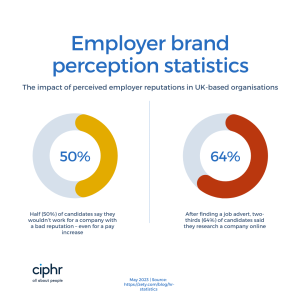
So far, we’ve explored how organisations can keep pace with evolving technology and workers’ preferences, shorten recruitment cycles in a difficult labour market, and regain valuable time spent on repetitive processes. But what role does technology play in enhancing your employer brand? How can software sincerely relay your values, mission and ethos, and provide candidates with the information they need to continue their application process?
The solution: intelligent automation does the heavy lifting
An automated hiring system can engage employees at the perfect time: interview prep, suggestions, and providing vital information on the organisation – its values, mission, vision, pay transparency, benefits, and details on what makes it a great place to work – can all lend to a positive experience. Rather than persuading a candidate to consider their future within your organisation, you can take control of the narrative by highlighting the benefits and values you’re proud to offer.
Automating communication that attracts, engages and delights future employees will not only reduce applicant churn, but it will solidify your brand reputation. Industry leader, ‘the place to be’, employer of the year: whatever your employer brand goals, intelligent automation in recruitment can help you achieve them.
The golden ticket to recruitment success
Five real problems, one clear solution. Your recruitment software plays a critical role in how successful your organisation is — now and in the long run. It may seem daunting to set up processes and implement automation, but with the right support and guidance from expert software providers, you’re best placed to transform the way you hire.
If you’re eager to explore how an investment in automated recruitment software can benefit your organisation, request an obligation-free demo of Ciphr iRecruit or download a brochure to learn more.
